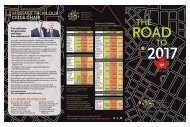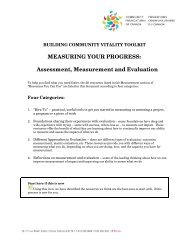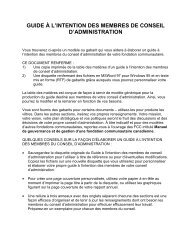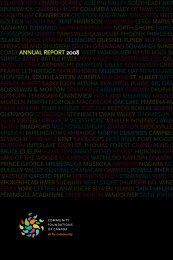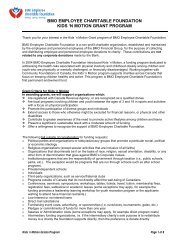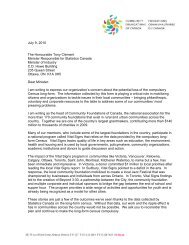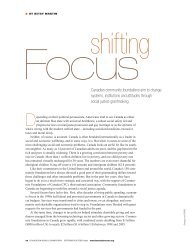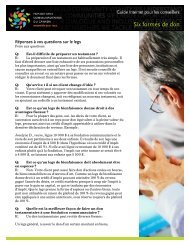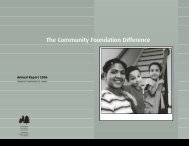Aboriginal Philanthropy in Canada: A Foundation for Understanding
Aboriginal Philanthropy in Canada: A Foundation for Understanding
Aboriginal Philanthropy in Canada: A Foundation for Understanding
Create successful ePaper yourself
Turn your PDF publications into a flip-book with our unique Google optimized e-Paper software.
Respondents described some of the key challenges<br />
to build<strong>in</strong>g effective communication as lack of<br />
understand<strong>in</strong>g, the isolation and remoteness of many<br />
First Nation communities and issues related to f<strong>in</strong>ances.<br />
One respondent said: “It was a challenge <strong>for</strong> face-toface<br />
meet<strong>in</strong>gs. They were not truly understand<strong>in</strong>g the<br />
f<strong>in</strong>ances – and this goes both ways. Communities are<br />
underfunded; there is a lack of transparency that is not<br />
necessarily deliberate.”<br />
Effective communication between foundations and<br />
First Peoples is especially important because they come<br />
from different cultures and must establish a common<br />
understand<strong>in</strong>g to work together. Respondents note<br />
that people, even with the best of <strong>in</strong>tentions, make<br />
assumptions that our way of proceed<strong>in</strong>g is appropriate.<br />
For example, many foundations th<strong>in</strong>k of social <strong>in</strong>clusion<br />
<strong>in</strong> terms of belong<strong>in</strong>g, acceptance and recognition and<br />
that it entails full and equal participation <strong>in</strong> economic,<br />
social, cultural and political <strong>in</strong>stitutions. They might<br />
expect First Peoples to readily embrace social <strong>in</strong>clusion<br />
as a concept. As one foundation learned, this wasn’t<br />
so:<br />
“The foundation was <strong>in</strong>volved <strong>in</strong> develop<strong>in</strong>g some<br />
work on social <strong>in</strong>clusion and we <strong>in</strong>vited people to<br />
provide papers on what it might look like. We found<br />
that <strong>Aborig<strong>in</strong>al</strong> peoples are not com<strong>for</strong>table with the<br />
language of social <strong>in</strong>clusion as, to them, we heard that it<br />
represented another aspect of assimilation.”<br />
Most foundation representatives <strong>in</strong>terviewed felt<br />
that foundations needed to change their established<br />
ways of do<strong>in</strong>g bus<strong>in</strong>ess to develop more productive<br />
relationships with First Peoples. One respondent said:<br />
“I f<strong>in</strong>d foundations are very conservative and that there<br />
are few progressive foundations <strong>in</strong> <strong>Canada</strong>. The degree<br />
to which they are transparent is small. Directories are<br />
not very clear.”<br />
Another stated:<br />
“I’m less concerned about the specific facts that<br />
need to be presented than I am about the manner<br />
of presentation of the facts about foundations.<br />
While community people f<strong>in</strong>d pr<strong>in</strong>ted materials and<br />
websites helpful, this isn’t the way that Indian people<br />
prefer to learn. Funders are always gett<strong>in</strong>g <strong>in</strong>vited to<br />
communities so that we can experience each other,<br />
talk with each other and better understand each other.<br />
This isn’t the way that foundations generally operate,<br />
although many of them have managed to make time <strong>for</strong><br />
that.”<br />
It is clear that foundations who truly desire to deepen<br />
their relationship with First Peoples will have to f<strong>in</strong>d<br />
ways to communicate that are relevant to <strong>Aborig<strong>in</strong>al</strong><br />
people.<br />
The different cultures of philanthropy and First<br />
Peoples cannot be underestimated. <strong>Foundation</strong>s often<br />
require considerable paperwork with standardized<br />
expectations and tight turn-around times that make the<br />
process of apply<strong>in</strong>g <strong>for</strong> fund<strong>in</strong>g a barrier <strong>in</strong> itself. In<br />
addition, if the project doesn’t fit <strong>in</strong>to the foundations’<br />
exact guidel<strong>in</strong>es, changes may be requested that<br />
compromise the orig<strong>in</strong>al vision, <strong>in</strong>tegrity and control of<br />
the project. An <strong>Aborig<strong>in</strong>al</strong> key <strong>in</strong><strong>for</strong>mant who works <strong>in</strong><br />
the non-profit sector described the process of apply<strong>in</strong>g<br />
<strong>for</strong> grant fund<strong>in</strong>g:<br />
“Tedious, time-consum<strong>in</strong>g and disappo<strong>in</strong>t<strong>in</strong>g ...ABC<br />
Agency was approved <strong>for</strong> fund<strong>in</strong>g a few years ago<br />
from both the XYZ <strong>Foundation</strong> and 123 <strong>Foundation</strong><br />
consecutively. However, when meet<strong>in</strong>g with the<br />
foundations’ representatives after the approval<br />
process, far too many changes were requested to the<br />
orig<strong>in</strong>al proposal and too much control of the project<br />
was stipulated. The decision was to decl<strong>in</strong>e the fund<strong>in</strong>g<br />
rather than jeopardize the <strong>in</strong>tent of the orig<strong>in</strong>al project.”<br />
“When funders move <strong>in</strong>to Indigenous communities they<br />
tread a very f<strong>in</strong>e l<strong>in</strong>e.”<br />
The Circle on <strong>Philanthropy</strong> & <strong>Aborig<strong>in</strong>al</strong> Peoples <strong>in</strong> <strong>Canada</strong> 28




